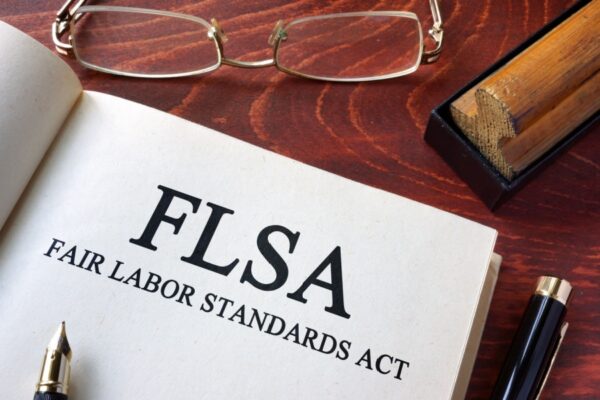Effective for 2014, the Affordable Care Act (ACA) imposes “pay or play” requirements on large employers to encourage them to provide group health plan coverage for their employees.
A large employer for this purpose is one that employed at least 50 full-time employees, including full-time equivalents, on business days during the preceding calendar year.
Large employers that do not offer any health coverage to all full-time employees or that offer health coverage to their full-time employees that is either unaffordable or does not provide minimum value may be subject to penalties. The penalty is known as a “shared responsibility payment.” The penalty is triggered if one full-time employee receives a premium tax credit or cost sharing reduction for coverage obtained through a health insurance exchange.
ACA defines a full-time employee as an employee who is employed on average for at least 30 hours of service per week. The definition of full-time employee is a key concept in determining to what extent an employer may incur a penalty under ACA’s “pay or play” rules.
On Aug. 31, 2012, the IRS issued Notice 2012-58 to describe safe harbor methods and rules that employers may use to determine which employees are treated as full-time employees for purposes of ACA’s shared responsibility provisions. IRS Notice 2012-58 also addresses a safe harbor based on Form W-2 wages for employers to use in determining whether their health coverage is affordable.
Employers may rely on the safe harbor methods and rules outlined in IRS Notice 2012-58 at least through the end of 2014. This reliance covers a measurement period that begins in 2013 or 2014 and the associated stability period, which may extend into 2014, 2015 or 2016. According to the IRS, employers will not be required to comply with any future guidance that is more restrictive on these issues until at least Jan. 1, 2015.
Determining Employees’ full-time status
Safe Harbor for Ongoing Employees
For ongoing employees, employers will be able to use the safe harbor measurement and stability periods previously described by the IRS in Notice 2011-36 and Notice 2012-17. Under this approach, an employer determines each ongoing employee’s full-time status by looking back at a measurement period lasting between 3 to 12 consecutive calendar months, as chosen by the employer, to determine whether the employee averaged at least 30 hours of service per week during this period. The employer has the flexibility to determine the months in which the standard measurement period starts and ends, as long as the determination is made on a uniform and consistent basis for all employees in the same category.
If the employee worked at least 30 hours per week during the measurement period, he or she would be considered a full-time employee for a set period of time into the future, known as the “stability period.” The stability period must be at least six calendar months following the measurement period and must be at least as long as the measurement period. The employee would be treated as a full-time employee during the stability period, regardless of the hours worked during that period, as long as he or she remained employed.
If an employer determines that an employee did not work full-time during the measurement period, the employer may treat the employee as not a full-time employee during the stability period that follows (but is not longer than) the measurement period.
Because employers may need time between the measurement and stability periods to determine which ongoing employees are eligible for coverage and to notify and enroll employees, Notice 2012-58 allows employers to use an “administrative period” between the measurement and stability periods. The administrative period following a measurement period can last up to 90 days.
Also, subject to the rules regarding the relationship between the length of the measurement period and stability period, employers may use measurement and stability periods that differ either in length or in their starting and ending dates for the following categories of employees:
- Collectively bargained employees and non-collectively bargained employees;
- Salaried employees and hourly employees;
- Employees of different entities; and
- Employees located in different states.
Rule for New Employees Expected to Work Full Time
An employer will not be subject to a penalty for not offering coverage to new full-time employees during the first three calendar months of employment. This rule applies where an employee is reasonably expected at his or her start date to work full-time and the employer sponsors a group health plan and offers coverage to the employee at or before the conclusion of the employee’s initial three calendar months of employment.
Safe Harbor for New Variable Hour or Seasonal Employees
A new employee is a variable hour employee if, based on the facts and circumstances at the start date, it cannot be determined that the employee is reasonably expected to work on average at least 30 hours per week. Through at least 2014, employers are permitted to use a reasonable, good faith interpretation of the term “seasonal employee” for purposes of determining the amount of any employer penalty.
If an employer maintains a group health plan that would offer coverage to an employee only if he or she is determined to have full-time status, the employer may use an “initial measurement period” lasting between 3 and 12 months (the same as allowed for ongoing employees) to determine whether new variable hour or seasonal employees are full-time employees. The employer measures the hours of service completed by the new employee during the initial measurement period and determines whether the employee completed an average of 30 hours of service per week or more during this period. During this measurement period, the employer would not be subject to a shared responsibility penalty under ACA with respect to these employees.
As in the case of a standard measurement period, if an employee is determined to be a full-time employee during the initial measurement period, the stability period must be a period of at least six consecutive calendar months that is no shorter in duration than the initial measurement period and that begins after the initial measurement period (and any associated administrative period).
If a new variable hour or seasonal employee is determined not to be a full-time employee during the initial measurement period, the employer may treat the employee as not a full-time employee during the stability period that follows the initial measurement period. This stability period must not be more than one month longer than the initial measurement period and must not exceed the remainder of the standard measurement period (plus any associated administrative period) in which the initial measurement period ends.
Once a new employee who has been employed for an initial measurement period, has been employed for an entire standard measurement period, the employee must be tested for full-time status, beginning with that standard measurement period, at the same time and under the same conditions as other ongoing employees.
Affordability Safe Harbor
In Notice 2011-73 and Notice 2012-17, the IRS described a safe harbor for employers to use in determining whether their health coverage is affordable under ACA’s employer penalty rules. In Notice 2012-58, the IRS confirmed that employers may rely on this safe harbor at least through the end of 2014.
Income Taken Into Account
The affordability of any health coverage offered by a large employer is a key point in determining whether the employer will be subject to a shared responsibility penalty. According to the statutory language of ACA, coverage is considered affordable if the employee’s required contribution to the plan does not exceed 9.5 percent of the employee’s household income for the taxable year. “Household income” was defined as the modified adjusted gross income of the employee and any members of the employee’s family, including a spouse and dependents.
Because employers may be largely unaware of the income levels of their employees’ family members, they could find it difficult to assess whether the coverage they offer would be considered affordable. To address this issue, the safe harbor measures the affordability of an employer’s coverage by reference only to an employee’s wages from that employer. Wages for this purpose would be the amount required to be reported in Box 1 of the employee’s Form W-2.
Eligibility for the Safe Harbor
To be eligible for the safe harbor, an employer must meet certain requirements:
- The employer must offer its full-time employees (and their dependents) the opportunity to enroll in minimum essential coverage under an employer-sponsored plan; and
- The employee portion of the self-only premium for the employer’s lowest cost coverage that provides minimum value (the employee contribution) must not exceed 9.5 percent of the employee’s W-2 wages.
If the employer satisfies both of these requirements for a particular employee, along with any other conditions for the safe harbor, the employer would not be subject to a penalty for providing unaffordable coverage with respect to that employee. This is the case even if the employee receives a premium tax credit or cost sharing reduction to purchase coverage through a health insurance exchange.
Timing of the Safe Harbor
Whether the safe harbor applies would be determined after the end of the calendar year and on an employee-by-employee basis, taking into account W-2 wages and employee contributions. However, an employer could also use the safe harbor prospectively, at the beginning of the year, by structuring its plan and operations to set the contribution for each employee at a level that would not exceed 9.5 percent of that employee’s W-2 wages for that year. Employers may also make adjustments for pay periods so that the employee contribution does not exceed 9.5 percent of the employee’s W-2 wages.
Safe Harbor Application
The affordability safe harbor would apply only for purposes of determining whether an employer’s coverage satisfies the 9.5 percent affordability test for purposes of the shared responsibility penalty under ACA. The safe harbor would not affect an employee’s eligibility for a premium tax credit, which would continue to be based on the affordability of employer-sponsored coverage relative to an employee’s household income.
This means that, in some instances, an employer’s offer of coverage to an employee could be considered affordable (based on W-2 wages) for purposes of determining whether the employer is subject to an penalty and the same offer of coverage could be treated as unaffordable (based on household income) for purposes of determining whether the employee is eligible for a premium tax credit.
Material posted on this website is for informational purposes only and does not constitute a legal opinion or medical advice. Contact your legal representative or medical professional for information specific to your legal or medical needs.



